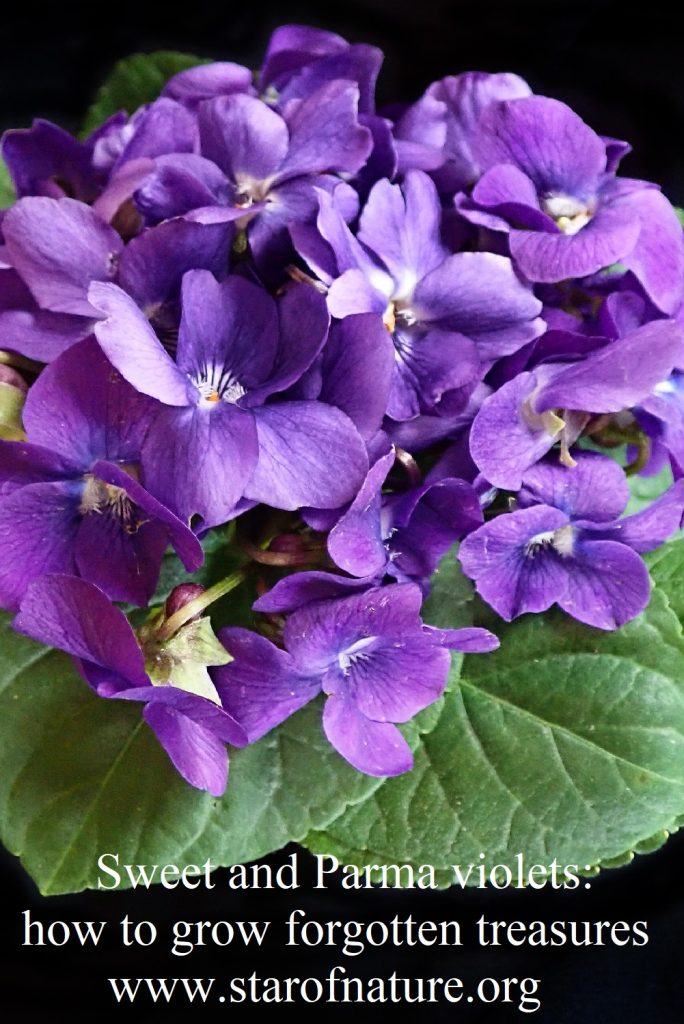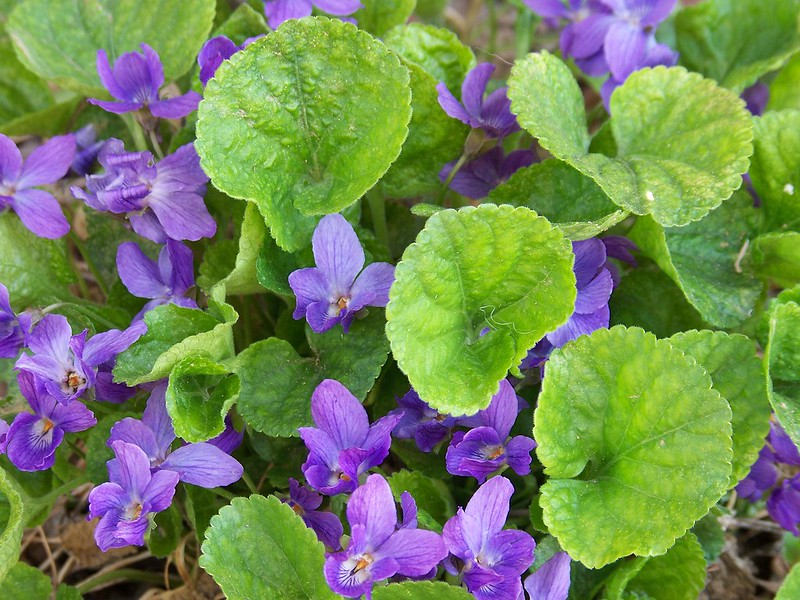Sweet Violet (Viola Odorata) and Parma Violet: How to Grow Forgotten Treasures
Violets were cultivated as decorative and medicinal plants already in ancient Greece, where they were sold in the Athenian agora and praised by Greek poets. They continued to be grown in Europe in the Middle Ages, but it was in the 18th and 19th centuries that they developed into a cultural phenomenon. This is when they became important economically, in literature, art, design and even in politics. Below I tell about the history of Parma and sweet violets, and explain how to grow these beautiful flowers.
Types of violets
The Viola family comprises about 400 species. This includes Viola tricolour, wild pansy, and its modern descendants, cultivated large-flowered winter pansies.
The Viola family also includes the common wild violet (Viola canina, ‘dog violet’) that is scentless and flowers profusely in March and April. It prefers semi-shade and grows in woods and parks. In gardens it can become invasive. Its small flowers are edible and come in a beautiful shade of dark blue.
The varieties that were widely cultivated in the 19th century were species of the scented violet, Viola odorata, and of Parma violet. Viola odorata or sweet violet is a small, hardy woodland perennial native to Europe. Parma violet is a distinctive subgroup within the Viola family. It is somewhat tender and best suited for cultivation in southern regions, such as Italy and the south of France. In ideal conditions Parma violets can flower for seven consecutive months, but rarely produce seeds.
For those familiar only with the wild scentless violet it is hard to imagine the richness of luxurious forms that were cultivated in the late 19th and early 20th centuries. They included continuously flowering varieties, double and large-flowered cultivars in a range of colours, including white, red, blue, lavender, purple and yellow. Because violets were used as cut flowers, growers developed and preferred varieties with long stems and flowers as large as 4.5cm.
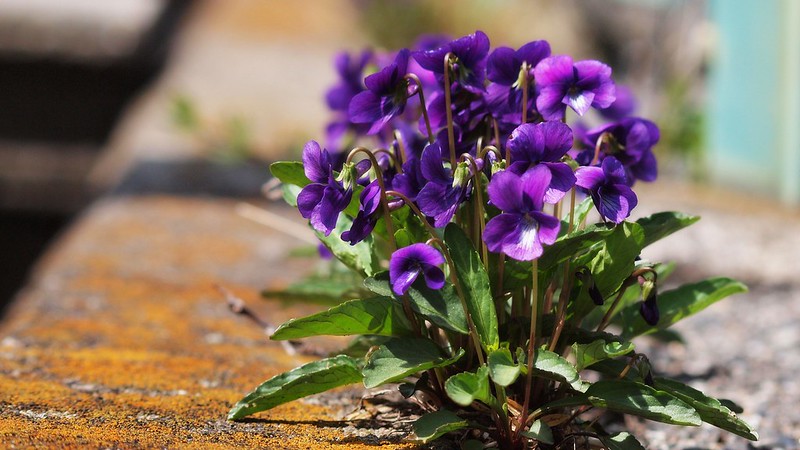
Growing sweet violet and Parma violet in the 19th century
In the second half of the 19th century in the Unites States and European countries violets were on sale all year round. In Europe the main producer was France that exported violets to other countries. But it was certainly not the only large producer – cultivation on a large scale also took place in Germany, Italy and Britain.
The demand for violets was constant and great: they were sold as pot plants, cut flowers and for perfume making.
Violets in France
In France a hundred hectares of land were used each year for open air violet cultivation. And in addition 20,000 cold frames were employed for out of season production. The main regions of cultivation were Paris, Toulouse and Côte d’Azur.
Since violets prefer semi-shade, they were grown in the south under trees in olive groves as a secondary crop, or in open fields with some protection from the sun. They were sold to the European royalty, the aristocracy and visitors to the French Rivera.
Some of the most widely cultivated varieties in France were forms of Viola odorata ‘Viollete des quatres saisons’ (‘Violet of Four seasons’, a continuously flowering form) and ‘The Czar’ (with large dark blue flowers).
Parma violets commonly grown in France included a particularly large-flowered ‘Souvenir de Millet Pèrе’ and gorgeous ‘La France‘, a prolific dark purple cultivar, with flowers of outstanding size and scent.
Violets in Paris
Parma violets were also grown in several neighbourhoods of Paris. Luís Mendonça de Carvalho and co-authors report that in 1898, describing the importance of Parma violets in Paris, a famous nurseryman Armand Joseph Millet wrote:
‘Everyone who has lived in Paris, even those who have merely passed through the city in March or April, have seen and admired those beautiful pots of violets which adorn our florists’ shops. All the covered markets and street markets are filled with them, flattering the eyes and filling the air of the metropolis with their sweet perfume. Well, it is the Parma violet again that supplies these quantities of plants’ (‘History and Cultivation of Parma Violets (Viola Violaceae) in the United Kingdom and France in the Nineteenth Century’, Harvard Papers in Botany 18(2) (2013),137-145).
It is estimated that at the beginning of the 1880’s, about six million violet bunches were sold every year in Paris.
Violets in Germany, Britain, and the United States
Germany had large farms with thousands of square metres of land dedicated to growing violets. One farm could produce 200,000 flowers just in a winter. In Britain violets were cultivated in Middlesex, Kent, Sussex and Devon. A 100 plants of a prolific double lavender cultivar ‘Lady Hume Campbell’, popular with British growers, could produce 600 to 1000 flowers weekly.
In the final decades of Queen Victoria’s reign violets were tremendously popular. Around 3000 plants were grown in Windsor Castle in pits protected with glass frames. The gardeners at Windsor Castle grew three cultivars: two Parma violets ‘Marie Louise’ and ‘Lady Hume Campbell’, and Viola odorata ‘Princess of Wales’.
In the United States violets were cultivated along the East Coast (New England) and in California (San Francisco). The village that became particularly important for violet cultivation was Rhinebeck (New York) where cultivars ‘Marie Loise’ and ‘Lady Hume Campbell’ were widely grown.
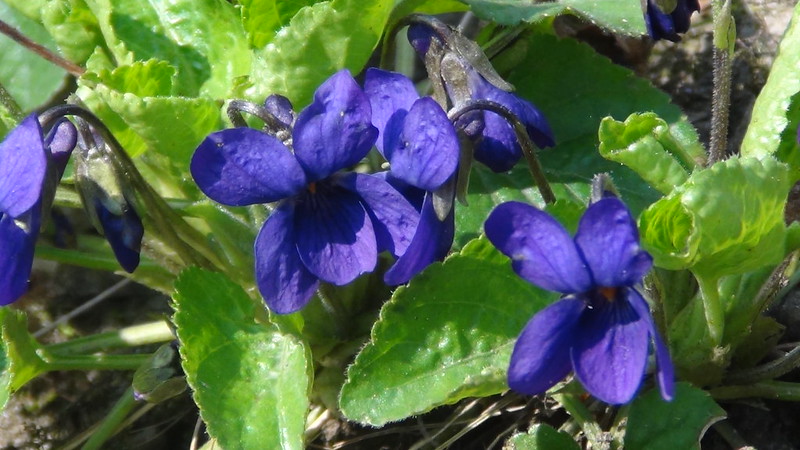
Parma and sweet violets and European royalty
Violets and Napoleon Bonaparte
In France violet became an emblem of the imperial Napoleonic party. Napoleon Bonaparte (1769-1821) was known to his supporters as Caporal violet (‘corporal violet’) or as Le pѐre de la violette (‘the father of the violet’).
When Napoleon abdicated and was banished to the island of Elba in 1814, he told to his followers before leaving that he would return when violets were again in season. As a result, violets became a symbol for his supporters who wore violet coloured watch ribbons and waistcoats.
When Napoleon escaped from Elba and returned to Paris on 20th March 1815, he was presented with a bouquet of violets. And when he was exiled to the Island of Saint Helena, after his final defeat at Waterloo (1815), violets became a symbol of rebellion against the restored monarchy of Louis XVIII.
The Duchy of Parma in Italy was given to Napoleon’s second wife Marie Louise, member of the Habsburg royal dynasty. She patronized violet fashion and trade in Parma violets.
Parma violets continued to be popular in France under the Second Empire (1808-73) ruled by Napolean III and his Spanish wife Eugenia. When the emperial couple were forced into exile in England, they brought their passion for violets with them. This increased the popularity of violets in the United Kingdom.
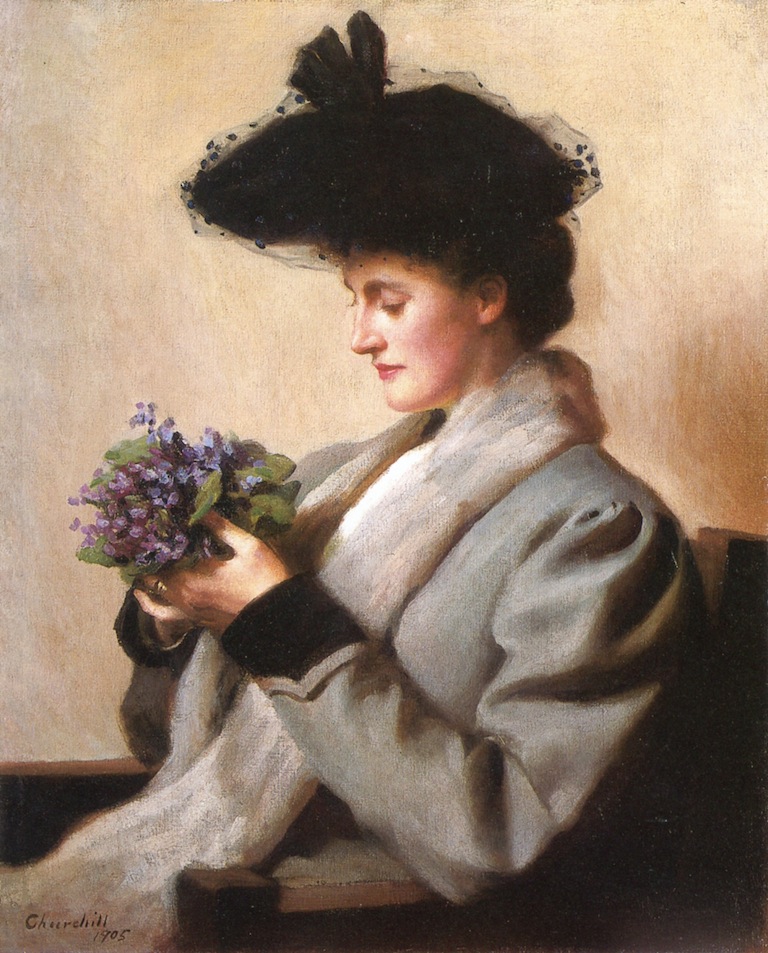
Violets’ aristocratic connections
Violets’ associations with royalty and aristocracy are evident in the names of popular varieties, such as Regina Victoria, Princesse de Galles (also Princess of Wales), Kronprinzessin von Deutschland, Kaiserin von Österreich, Kaiser Wilhelm II, Princessin Beatrix, Königin Charlotte, Maria Louise, Prinzessin Irene and Deutsche Kaiserin, to name just a few.
They were indispensable at balls, concerts and opera, and as decorations of wealthy homes around the year, including Christmas. They were the flower of Valentine’s day before roses. And they were made into both wedding bouquets and funeral wreaths.
Violets went out fashion after the First World War due to modernisation and changes in fashion in 1920s and 1930s. Unfortunately they never regained their former status.
How to grow violets in the garden
Growing violets for cut flowers
Scented large-flowered violets, grown for cut flowers, prefer moist, deep, rich and heavy soil, clay rather than sand. They can grow both in sun and in semi-shade.
19th-century growers typically planted four rows of young plants in beds one metre wide, leaving the distance of 15-20cm between plants. Plants were then watered and kept weed free in the summer. Organic mulch, particularly well rotted manure was spread around them during the growing season. Growers applied about 2-3cm of manure in June and sometimes more later in the summer.
Similarly to pansies, Parma and sweet violet are cool weather plants and flower, depending on the variety, in spring, autumn or both.
Violets in borders
Scented violets with large flowers can be grown around the edges of borders containing taller flowers and shrubs. Some large-flowered varieties are not fully hardy and may need protection in winter. To protect them cover them with leaves, straw or fir tree branches in late autumn.
19th-century gardening books recommend dividing and replanting violets every 3 years. If they are to be grown in the same place, the soil needs to be partly replaced and improved with compost.
Growing Viola odorata and wild violet
Native Viola odorata and wild violet (Viola canina and other species) are both very hardy and beautiful. They can be naturalised in shady areas of the garden, including lawns and areas under trees. They therefore can provide ground cover in shade where grass does not grow well.
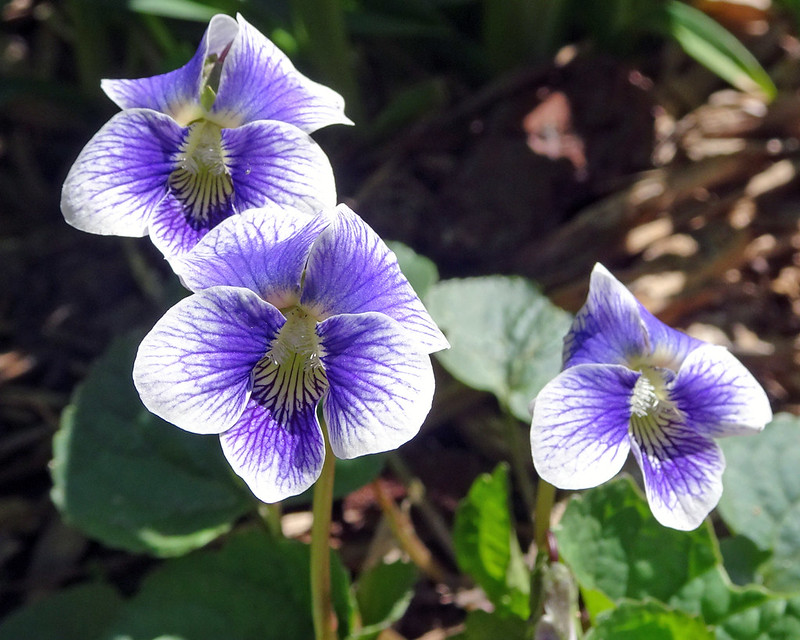
How to grow violets in winter
Growing violets under glass frames
In the 19th century violets were grown in warm beds under glass to produce flowers in winter. Pits under frames were filled with organic material, such as bark, leaves, grass and spent cuttings from vegetable gardens that produce heat as they decompose. These were covered with a deep later of soil into which violets were planted. They were then covered with glass frames.
Violets require cool conditions when they flower – some flower at 5-6C, but most at 8-10C. So the frames were closed at night, and left partially open during the day if the weather was not too cold. In such conditions violets flowered in September-November and even December, and then after a break again in early spring.
Growing violets in glass houses
Another method of producing flowers in winter was to grow violets in pots in glass houses. Violets were planted in pots at the end of July if they were to flower in early autumn. If they were to flower later, they were planted in Septemder. They were then kept in shade, watered frequently, fertilized, and any yellowing leaves removed.
In October pots were moved into a cold dark storage where plants were kept dormant until needed. They were then gradually moved into a glass house, watered and fertilized.
The temperature was kept 5-6C at night and 8-10C during the day to imitate conditions of early spring. Temperature higher than 10C results in fast growth that weakens the plants and causes them to produce lots of leaves, but smaller flowers.
Plants in pots flowered for 6-7 weeks. As they finished flowering, new pots were moved into the growing space. Pots that finished flowering were given 40 days of rest by keeping them cold and dry. After this they could be used again in the same way, with a similar result.
Varieties that did well grown in winter included Viola odorata ‘The Czar’ with large leaves and flowers, and dark blue constantly flowering Viola odorata ‘Regina Victoria’. Double varieties are less suitable for growing in winter.
In the summer, plants were taken out of pots, divided, planted in beds, watered and fertilized. In autumn the whole process was repeated.
How to propagate violets
Violets can be grown from seed or cuttings. To grow them from cuttings, cut off the tops of their shoots after flowering and insert the cuttings in potting compost. Keep moist. They will produce roots after about two weeks.
Violets symbolism
Because of its smell sweet sweet violet was believed to have seductive and alluring properties. In ancient Greece it was frequently depicted with the goddess of love, Aphrodite.
Since it is one of the first spring flowers, it became a symbol of love and spring. In the 19th century in Europe dried violets were enclosed in love letters and kept as a memento.
Violet was also a symbol of chastity, purity, modesty and humility. At the Viennese court of Duke Leopold VI (1198-1230) it was customary to search the Danube region for the first sweet violet in March. The finder would immediately inform the duke. The duke and his entire court would then go to the spot to formally greet the violet. And finally the most modest of the maidens would be permitted to pick it.
Violets in the language of flowers
In the language of flowers wild pansy (Viola tricolour) signifies ‘you are in my thoughts’ and sweet violet – humility and modesty.
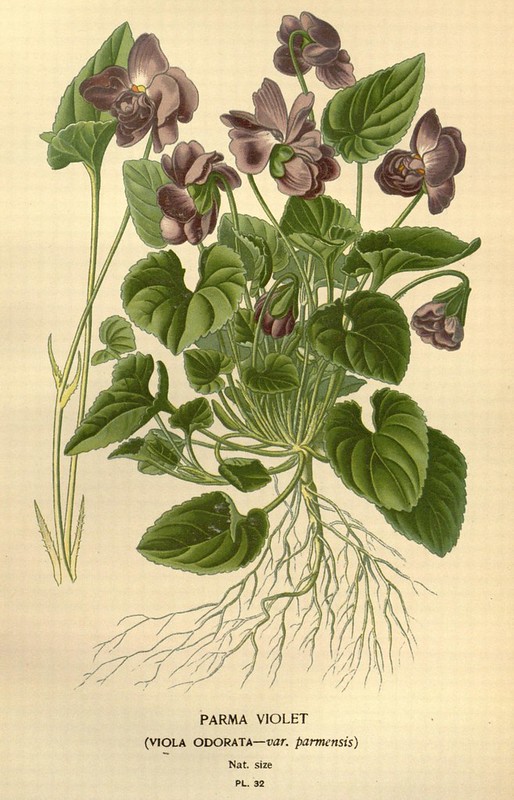
Using sweet violet
Violets in a vase or glass
Fill a vase with water almost to the brim – violets will last the longer the more their stalks are submerged in water. Add a few pieces of charcoal to keep the water fresh.
Violets are best put in a vase lightly tied together, so that the entire opening of the vase is filled up. Put leaves around the edges of the opening.
Basket of violets
Fill a small basket with damp moss. Put violets tied in small bunches on top, so that stems are submerged in moss.
Wrap a stem of ivy around the handle of the basket, and tie a purple bow either on top in the middle of the handle, or at its base.
Sweet violet corsages and buttonholes
Violet corsages and buttonholes were worn by both men and women in the second half of 19th century. The famous British writer Oscar Wilde is depicted with a posy hanging off his trouser belt.
To make a corsage bind in small round posy of 25 or 50 violets, and encircle it with a wreath of green leaves.
Such posies were still available for purchace in 1976 in London’s ‘South Kensington ‘ underground station, and in the late 1990s in florists’ shops in Marais in Paris.
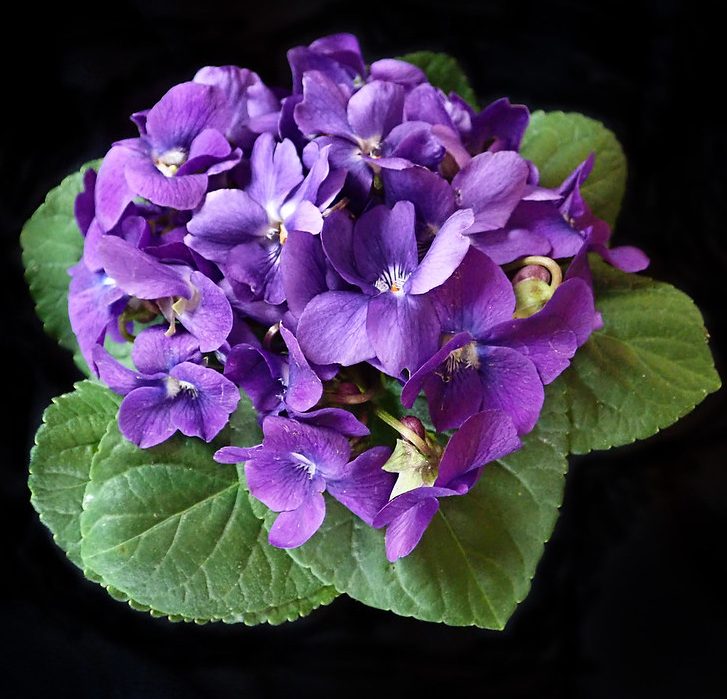
Sweet violet wedding bouquet
Violets were commonly used to make wedding bouquets. Such bouquets were popular and considered to be very good taste. Below is a description of a wedding bouquet from a 19th-century book.
Make a centre of the bouquet of yellow roses and small branches of flowering myrtle. Surround it with bunches of violets, each containing five flowers tied together. Roses should rise above the foundation of blue violets.
Violet wreath
To tell the whole truth what follows is a description of a funeral wreath from a 19th-century book. Violets had associations with death already in ancient Greece, where they were part of legends about the goddess of the underworld Persephone.
Make a diadem-shaped wreath of thuja bunches. Decorate with alternating magnolia leaves and bunches of dark violets.
Tie violets in bunches of 10 and position them in such a way that there is only one row of bunches in the narrow part at the bottom of the wreath, and three rows in the wide part at the top of the wreath. Make a bouquet of dark red roses and place it at the top of the wreath, in the middle of its widest part.
Violets were made into wreathes, however, not only for tragic events, but also for celebrations. Greek naturalist Pliny the Eldar (77 AD) tells that farmers of his day harly ever use garden plants to make wreaths, but mainly violets and roses. Yellow roses were most popular at that time.
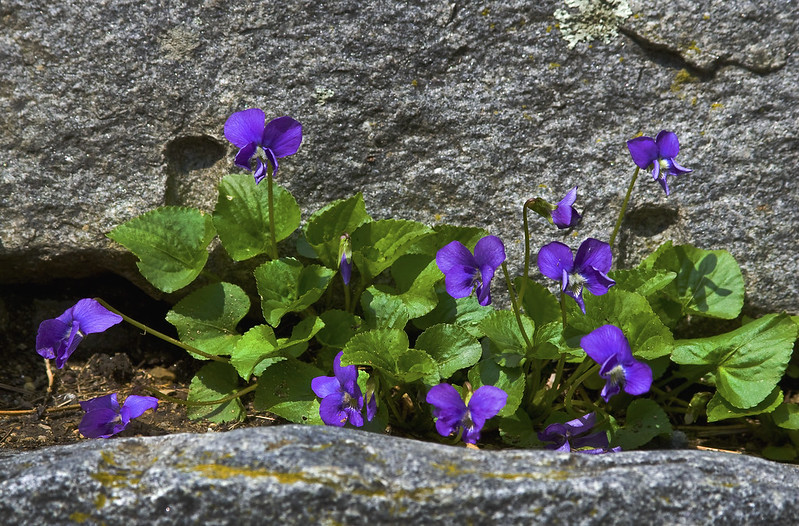
Wild and sweet violets as edible decorations
Leaves and flowers of wild and sweet violet are edible and can be used in salads and as a decoration in cakes and ice-creams.
Sweet violet candy
At the peak of violet fashion candied violets were very popular and produced commercially. Parma violets were made into sweets in Tolouse, consumed in France and exported to the United States. Between 500 and 1000 flowers were needed to make one kilogram of violet candy.
It is easy to make crystalized or candied violets at home. Parma, wild or sweet violet can all be used. Lightly beat the egg white and paint flowers with it using a brush. Coat in dusting sugar and place on baking paper for several hours to dry.
To make violet candy, flowers can be also dipped in hot sugar syrop and then dusted with fine sugar.
Sweet violet syrop
There are many old recipes of deserts made with sweet violet. During the Middle Ages a pudding prepared with violet syrop, called Mon Amy, was a much loved desert.
To make it, pour 1 litre of hot water over 50 grams of violet flowers (without their calyxes). Leave to stand over night. The following day filter the liquid. Add 150 grams of sugar. Heat for 20 min, letting sugar to disolve. Strain through linen cloth.
Sweet violet perfume
The flowers of violets were commonly used to make perfume in the 19th century. One of the centers for the production of violet-based perfumes was the town of Grasse on the French Rivera, where violets were grown.
Parma violet is still cultivated in southern France for the perfume industry. About 100 kilos of flowers are necessary to produce 31 grams of violet oil. However, cheaper artificial substitute aromas, such as ionone, are more commonly used today.
The perfume industry started to use ionone in the 19th century. It is a molecule that resembles the violet fragrance. Now synthetic ionone is used, but originally it was isolated from the root of the White Flag iris (Iris x germanica L. var florentina). When dried, the root indeed smells like violets.
To make violet perfume at home, fill a bottle or a jar with sweet violet flowers. Add vodka to cover the flowers. Leave to infuse for at least two weeks and strain.
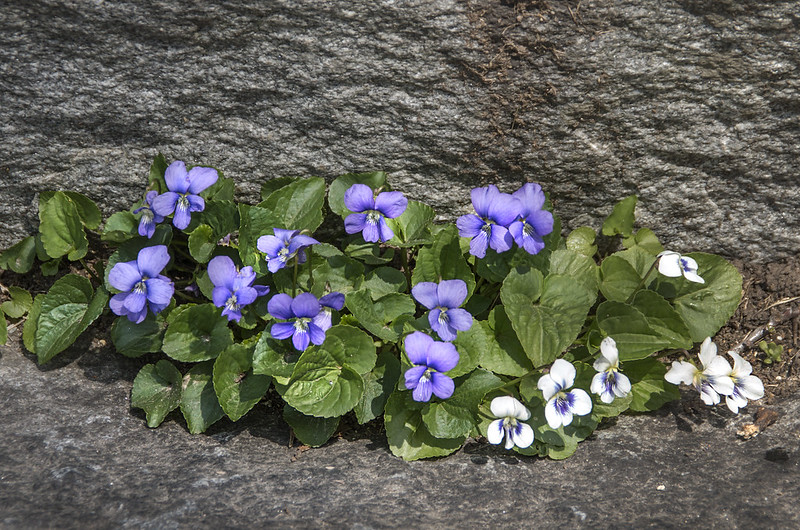
Oil of sweet violet
In the Middle Ages oil of violets was used as medicine and perfume. A bottle was filled with flowers of sweet violet and then fine table oil was poured over them. The bottle was left in the sun for 20 days and then the oil was strained. It was rubbed over temples to sooth headache and provoke sleep.
The use of oil, made with leaves rather than violet flowers, is described in The Book of Fruits and Flowers by Thomas Jenner (1653).
For more information on violets see Compendium of Symbolic and Ritual Plants in Europe, 2 volumes, ed. M. de Cleene and M. C. Lejeune (Ghent, 2002-2003). It is a fantastic resource for cultural history of many plants.
Image credits: featured image – sweet violets by Patrick Standish; roadside violet by coniferconifer; violets by Mariya Chorna; ‘The Nosegay of Violets’ by Irina (Flickr); violets by Maia C; Parma violet from Favourite flowers of garden and greenhouse (London and New York: Frederick Warne co.,1896-9); violet bunch by Beverly Buckley (Flickr); wild violets by Liz West; spring violets by Liz West.
Posts related to ‘Sweet Violet (Viola Odorata) and Parma Violet: How to Grow Forgotten Treasures’
Sweet Violet (Viola Odorata) in History: A Symbol of Joséphine and Napoleon Bonaparte
Growing Forget-me-nots; Forget-me-nots in Legends and History
Growing Lily-of-the-valley in Winter
Reblooming Amaryllis: Two Ways to Grow Amaryllis Bulbs Indoors
Pin ‘Sweet Violet (Viola Odorata) and Parma Violet: How to Grow Forgotten Treasures’ for later
